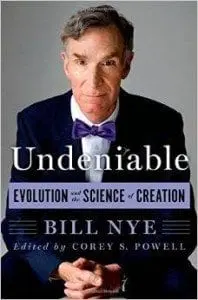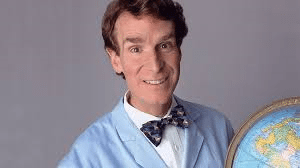
[First published in 2015] Bill Nye calls himself “The Science Guy,” but he sometimes acts in ways that can only be described as anti-science. For example, in a video he stated that creationism shouldn’t be taught to children. This, of course, is blatantly anti-science, because scientific progress is built on the competition of ideas. If you say that an idea shouldn’t be considered because you don’t like it, you are working against science, not for it.
In addition, he narrated a video about global warming that contained a faked experiment! Faking experiments is definitely not pro-science! Nevertheless, Nye obviously loves science, which leads me to wonder why he sometimes acts against it.
After reading Nye’s book, Undeniable: Evolution and the Science of Creation, I think I understand. He simply doesn’t inform himself on scientific issues. As a result, he really doesn’t understand science and doesn’t understand why some of his actions are so anti-science. Consider, for example, what he writes about kids who are taught creationism:
Not only that, these kids will never feel the joy of discovery that science brings. (p.10)
This, of course, is demonstrably false. Had Nye bothered to inform himself about kids who are taught creationism, he would find that they often do better in science than their peers who were not taught creationism. In addition, he would have learned that many kids who were taught creationism are now studying science at the university level or are already professional scientists. I have several students, for example, who say that the reason they decided to become scientists was because of my creationist textbooks (see here and here, for example)!
Of course, the fact that Nye is utterly uninformed about creationism leads to all sorts of problems with his book, which I have detailed in the PDF document at the end of this review. What really surprised me, however, is that his book shows that he hasn’t really informed himself about the science related to evolution, either. As a result, much of what he says in the book is utterly false.
Consider, for example, his discussion of the Second Law of Thermodynamics. He says that some creationists try to use the Second Law to refute evolution, but they shouldn’t. I agree with him on that point. As I have argued before (see here and here), the Second Law does not forbid evolution. It does, however, put constraints on evolution, and Nye doesn’t understand this, because he hasn’t informed himself on what the Second Law of Thermodynamics is all about. I find this particularly odd, because he was an engineer at one time, and engineers should understand the Second Law. Nye doesn’t. He says that it doesn’t apply to evolution because:
The Second Law applies only to closed systems, like a cylinder in a car engine, and the Earth is not even remotely a closed system. (p. 21)
This, of course, is completely false. First, the cylinder in a car engine is not even remotely a closed system. It dissipates heat into its surroundings, and it transfers mechanical energy to the engine. Thus, it is anything but a closed system! Second, and more importantly, of course the Second Law applies to open systems!
Think, for a moment, about the process by which water freezes. When water is a liquid, its molecules can move about within the confines of the container. However, when water is a solid (ice), its molecules only vibrate. As a result, in order for water to freeze, it must release energy into its surroundings. This is an entirely open system, and guess what determines the temperature at which the water will freeze. The Second Law of Thermodynamics.
When water freezes, it goes from a state of high disorder to a state of lower disorder. The Second Law, however, says that the universe can never get more ordered. It can only increase in disorder or stay the same in terms of order. As a result, for the water to freeze, the energy it releases upon freezing must disorder the surroundings more than the water becomes ordered. That way, the universe continues to get more disordered. For water, this happens for all temperatures lower than 0 degrees Celsius. Thus, water freezes at zero degrees Celsius because that’s when it can obey the Second Law of Thermodynamics. The behavior of this completely open system, then, is determined by the Second Law. Anyone who is informed about thermodynamics should understand that the Second Law applies to all systems, open and closed.
As another example of how his unwillingness to inform himself hampers his understanding of evolution, Nye tries to develop an equation to explain altruism, the act of self-sacrifice when there is no apparent gain for the one making the sacrifice. He ends up with this equation:
b > c/r
where “b” is the benefit to the organism, “c” is the cost, and “r” is the relatedness of the organism for which the sacrifice is being made. The more closely related the organisms, the larger “r” is. The idea is that altruism might have an evolutionary benefit, as long as the organisms are related.
For example, an animal might put itself in harm’s way to save another animal in the same pack, because they are related. Since they are related, the animal instinctively knows that the relative will help it survive, and if nothing else, some part of its genes will survive with the relative. If these benefits are greater than the cost divided by the relatedness, evolution says it is in the best interest of the animal to do the generous act. This equation, then, attempts to explain how altruism is compatible with evolution. However, as Nye admits, the equation doesn’t work. Thus, even though he spends two chapters trying to explain altruism from an evolutionary viewpoint, he can’t.
That’s not the end of the story, however. The discussion makes it clear that Nye doesn’t understand the equation! He says:
The fraction on the right-hand side never goes to zero: You, as a human, will tend to save the kid even if he or she is completely unrelated (p. 221)
The more distantly related the organisms, the smaller r gets. Thus, for the scenario of a person risking his life for an unrelated kid, r is very near (if not equal to) zero. When r is that small, the fraction on the right-hand side doesn’t approach zero. It approaches infinity! This, of course, makes sense. If the organisms are distantly related, the benefit would have to be very high for altruism to occur. Nye doesn’t understand this basic aspect of the equation.
Perhaps the one thing that best demonstrates Nye’s inability to inform himself on the issues that he wishes to discuss is this statement about creationism:
Creationism, unlike science, can predict nothing. (p. 163)
This is completely false, and Nye knows it is false. He made that statement in his debate with Ken Ham, and Ham showed him it was false. Rather than trying to inform himself on the issue, however, he completely ignored what Ham showed him and did not bother to see if creationism had made any predictions.
If he had bothered to inform himself on the issue, he would have found that creationism has made a lot of predictions, and many of them have subsequently been confirmed by the data. A young-earth creationist model of planetary magnetic fields, for example, has made several predictions, all of which subsequent data confirmed (see here, here and here). A young-earth study of helium trapped in zircons made a prediction about the diffusion rate of helium in zircon, and it was confirmed by the data. Creationists long predicted that the human appendix is not vestigial, and subsequent data confirmed that (see here, here, and here). Creationists have predicted that genomes have limits on how much they can change, and the longest-running evolution experiment has confirmed that. Here are a few more predictions that have been made as a result of the creation model and have been confirmed by the data. It’s unfortunate that Nye doesn’t want to inform himself on the issues about which he writes and speaks.
If you are interested in a more detailed list of the errors in Nye’s book, most of which are the result of him refusing to inform himself on the creation/evolution debate, feel free to look at this PDF.
While I am sure it doesn’t contain all of the errors in his book, it does contain the ones that I found when I read it.







